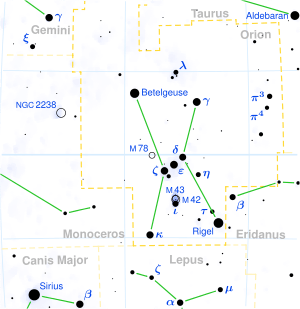11 Orionis
| Observation data Epoch J2000 Equinox J2000 | |
|---|---|
| Constellation | Orion |
| Right ascension | 05h 04m 34.14916s[1] |
| Declination | +15° 24′ 14.7771″[1] |
| Apparent magnitude (V) | 4.65[2] |
| Characteristics | |
| Spectral type | B9 IV[3] |
| U−B color index | -0.10[4] |
| B−V color index | -0.06[4] |
| Variable type | α² CVn[5] |
| Astrometry | |
| Radial velocity (Rv) | +16.80[6] km/s |
| Proper motion (μ) | RA: +17.80[1] mas/yr Dec.: -31.15[1] mas/yr |
| Parallax (π) | 8.93 ± 0.24[1] mas |
| Distance | 365 ± 10 ly (112 ± 3 pc) |
| Absolute magnitude (MV) | -0.59[2] |
| Details | |
| Luminosity | 220[2] L☉ |
| Temperature | 9,520[3] K |
| Rotational velocity (v sin i) | 36[7] km/s |
| Other designations | |
| Database references | |
| SIMBAD | data |
11 Orionis (11 Ori) is a blue supergiant star in the constellation Orion. Its apparent magnitude is 4.65[2] and it is approximately 365 light years away based on parallax.[1] It is a chemically peculiar star known as an Ap star, with enhanced Silicon and Chromium lines in its spectrum.[8]
It is an α² CVn variable, ranging from 4.69 to 4.65 magnitude with a period of 4.64 days.[5]
References
- 1 2 3 4 5 6 Van Leeuwen, F. (2007). "Validation of the new Hipparcos reduction". Astronomy and Astrophysics. 474 (2): 653. arXiv:0708.1752. Bibcode:2007A&A...474..653V. doi:10.1051/0004-6361:20078357. Vizier catalog entry
- 1 2 3 4 Anderson, E.; Francis, Ch. (2012). "XHIP: An extended hipparcos compilation". Astronomy Letters. 38 (5): 331. arXiv:1108.4971. Bibcode:2012AstL...38..331A. doi:10.1134/S1063773712050015. Vizier catalog entry
- 1 2 Zorec, J.; Cidale, L.; Arias, M. L.; Frémat, Y.; Muratore, M. F.; Torres, A. F.; Martayan, C. (2009). "Fundamental parameters of B supergiants from the BCD system. I. Calibration of the (λ_1, D) parameters into Teff". Astronomy and Astrophysics. 501: 297. arXiv:0903.5134. Bibcode:2009A&A...501..297Z. doi:10.1051/0004-6361/200811147.
- 1 2 Mermilliod, J. C. (2006). "VizieR Online Data Catalog: Homogeneous Means in the UBV System (Mermilliod 1991)". VizieR On-line Data Catalog: II/168. Originally published in: Institut d'Astronomie. 2168. Bibcode:2006yCat.2168....0M. Vizier catalog entry
- 1 2 Samus, N. N.; Durlevich, O. V.; et al. (2009). "VizieR Online Data Catalog: General Catalogue of Variable Stars (Samus+ 2007-2013)". VizieR On-line Data Catalog: B/gcvs. Originally published in: 2009yCat....102025S. 1. Bibcode:2009yCat....1.2025S.
- ↑ Wilson, R. E. (1953). General Catalogue of Stellar Radial Velocities. Carnegie Institution for Science. Bibcode:1953GCRV..C......0W. LCCN 54001336.
- ↑ Hoffleit, D.; Warren, W. H. (1995). "VizieR Online Data Catalog: Bright Star Catalogue, 5th Revised Ed. (Hoffleit+, 1991)". VizieR On-line Data Catalog: V/50. Originally published in: 1964BS....C......0H. 5050. Bibcode:1995yCat.5050....0H.
- ↑ Stigler, Ch.; Maitzen, H. M.; Paunzen, E.; Netopil, M. (2014). "Spectrophotometric analysis of the 5200 Å region for peculiar and normal stars". Astronomy & Astrophysics. 562: A65. arXiv:1402.1021. Bibcode:2014A&A...562A..65S. doi:10.1051/0004-6361/201322300.
This article is issued from
Wikipedia.
The text is licensed under Creative Commons - Attribution - Sharealike.
Additional terms may apply for the media files.
